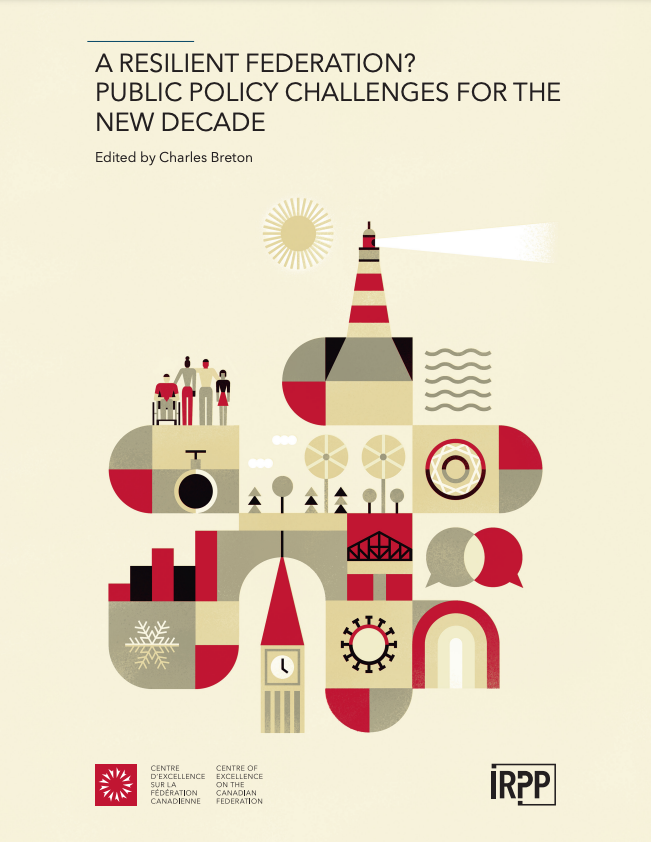Reimagining the Canadian Federation through an Urban Lens
INTRODUCTION
The devastating health, social and economic impacts of COVID-19 are most pronounced in Canada’s cities. Two-thirds of all cases and 75 percent of all deaths have occurred in Canada’s 20 largest municipalities.[1] Greater Montreal, Toronto and Calgary alone account for half of all cases and deaths. The pandemic has also laid bare the precarious financial footing of city governments across the country. Due to a sharp drop in revenues, municipalities face a combined annual operating shortfall of $10-15 billion.[2]
Successful recovery will require extraordinary collaboration between federal, provincial and municipal governments. This can only be achieved by building stronger political institutions linking all three levels. Crucially, it will also require a more fundamental reimagining of the Canadian federation through an urban lens, acknowledging the importance of city-regions and metropolitan centres in the Canadian policy landscape. The status quo is no longer an option. We require a new intergovernmental infrastructure that enables policy-makers at all levels to better understand the needs of our cities and city-regions, and respond with concerted action.
Common Misconceptions about Cities in Canada
First is the truism that more than 80 percent of Canadians live in urban areas. Mayors routinely employ this statistic to demand greater respect and powers for municipal governments within Canada’s constitutional framework. But the threshold for what qualifies as an “urban area” in Canada is so low, by international standards and as a matter of common sense, that the figure diminishes the political importance of cities. Take the Town of Two Hills, Alberta, which has a population of 1,352. Statistics Canada considers it to be equally “urban” as the City of Edmonton, which has a population of 1 million.[3] In all, only 100 of Canada’s 4,000 or so municipalities have populations greater than 50,000. This leads to a false impression that city issues are trivial and inconsequential — “small town stuff” — compared to federal or provincial matters. Yet nearly 23 million Canadians reside in these 100 municipalities.
Second is the belief that all cities, no matter their size, location or economic importance, deserve equal treatment. Due to COVID-19, municipalities large and small face crippling declines in property taxes and user fees, by far the two largest sources of own-source revenues. But not all city governments face this financial burden equally. Consider that by the end of 2020, the City of Toronto’s projected revenue loss from transit fares alone, which have declined 85 percent due to COVID fears, is expected to reach $800 million. That is equivalent to the entire operating budget of neighbouring Mississauga, Canada’s sixth largest municipality by population.
Third is the illusion that most cities are governed by a single city government, when, in fact, more than two-thirds of Canadians live in city-regions mainly comprised of fast-growing suburban municipalities.[4] More people, for example, live in Vancouver’s suburbs (the municipalities of Richmond, Surrey, Burnaby, Abbotsford, and the like), with a combined population of 1.8 million, than in the City of Vancouver proper, with its population of 675,000. Together, these areas operate as functionally integrated regional economies, measured by Statistics Canada as “census metropolitan areas” (CMAs), which collectively account for nearly 75 percent of Canada’s gross domestic product.[5] Yet they are governed by dozens (or in extreme cases, hundreds) of local and regional authorities.[6] Greater Montreal, for instance, consists of 82 distinct municipal governments within the formal boundaries of the Montreal Metropolitan Community. This makes it difficult to determine who speaks, or who should speak, for cities and city-regions in the federation.
Fourth is the mistaken assumption that city services are exclusively decided by, paid for and delivered by municipal governments. On the contrary, nearly everything cities do depends in some way on intergovernmental coordination, cooperation or investment. As the COVID-19 pandemic has made clear, local public health units coordinate daily with provincial and federal counterparts. Immigrant settlement policy is now defined by trilateral government arrangements.[7] So too are infrastructure investments, such as the federal Gas Tax Fund, which provides municipalities with $2 billion in permanent, annual funding through the provinces for roads, highways, water and sewer projects.
In short, urban governance is not simply municipal governance. Urban policy-making necessarily involves all levels of government. This is especially true in large cities, which depend on capital-intensive public services, such as mass transit and social housing. Conventional understandings of Canadian federalism continue to neglect this multi-level reality.
Cities Are Not Merely Creatures of the Provinces
Despite the complexities of urban governance in Canada, most policy-makers continue to treat all cities the same: as mere “creatures” of the provinces. The federal government’s initial COVID-19 Economic Response Plan included hundreds of billions of dollars for provincial governments, Indigenous communities, large industries, small businesses, the charitable sector, universities, students, you name it. Yet not one penny was allocated directly to municipalities. It took four months of negotiation between federal and provincial governments, with limited input from city leaders, to reach a Safe Restart Agreement that dedicated just $2 billion in emergency funds to cover municipal operating costs and another $1.8 billion in available operating funds for transit, conditional on provincial cost-matching. At best, this money eases only a fraction of the financial pressure faced by cities, and likely only for the next six months.[8] When asked to explain the delay, Prime Minister Justin Trudeau returned to a parochial narrative saying, “it is up to the provinces to manage and fund municipalities.”[9]
The Prime Minister is well aware that the role of cities in the federation is far more fluid than the constitutional division of powers suggests. Certainly, provincial governments play a dominant role. Several provinces have recently imposed (or threatened to impose) large-scale restructuring of municipal institutions. Many continue to centralize policy-making authority in traditional areas of local jurisdiction, such as land-use planning. But at the same time, most provincial governments have amended their legislative frameworks to formally recognize municipalities as legitimate, democratic and accountable orders of government. Since the 1990s, nearly every province has expanded the scope of authority delegated to local governments, adding more permissive language to existing municipal legislation or, in rare circumstances, establishing separate city charters.[10]
Federal engagement in urban affairs is also evolving. True, Canada remains one of only a handful of countries in the Organisation for Economic Cooperation and Development (OECD) without an explicit national urban policy. The federal government has not operated anything resembling a dedicated ministry of cities since the 1970s.[11] Direct federal transfers to municipalities have never totalled more than 1 percent of equivalent transfers to provinces.[12] High-profile federal funding programs meant for cities, such as the Gas Tax Fund, the Public Transit Infrastructure Fund and the National Housing Strategy, intentionally flow through the provinces. That said, successive federal governments have also clearly pursued an “implicit” urban agenda, announcing a variety of programs that, although not explicitly designed for cities, nevertheless have their most significant impacts in cities, such as the Homelessness Partnering Strategy, Local Immigration Partnership Councils and the Innovation Superclusters Initiative.[13]
All told, federal-provincial-municipal relations operate within a byzantine system of bilateral (federal-provincial, federal-municipal or provincial-municipal) and trilateral agreements, frameworks and transfers programs, each negotiated under unique circumstances. Such a disjointed intergovernmental architecture virtually guarantees a merry-go-round of short-term gains and long-term failures. Without institutional deterrents for senior governments that wish to renege on their commitments, any deal struck at one point in time is extremely vulnerable to changing political winds. A structural solution is needed.
Cities Need a New Intergovernmental Infrastructure
Those sympathetic to the plight of cities often argue for formal recognition of municipalities in the Canadian Constitution, as is the case in federal countries such as Germany, Brazil and South Africa. In this series of essays, Kristin Good creatively suggests securing these protections within provincial, rather than federal, constitutions. Both strategies, however, fall prey to the same conceptual trap: they reduce urban issues — by definition, multilevel in nature — to the narrow domain of municipal government.
Cities do not need new constitutional protections. They need a new intergovernmental infrastructure that suits the realities of urban policy-making. Federal institutions must be remade to give voice to city leaders and to enable greater dialogue between all levels of government on decisions that affect life in cities. That starts with three ingredients: better data, better organization and better interfaces.
Federal and provincial policy-makers have trouble appreciating the importance of cities, in part, because they lack consistent, comparable data that captures the gravity of economic, social and environmental conditions in cities across the country. We need more systematic evidence to guide intergovernmental intervention and cooperation. The Canadian Institute for Health Information underpins federal-provincial discussions on health care by collecting robust, comparative data and producing impartial analyses of health systems across the country. Applying an urban lens to federal-provincial-municipal discussions requires a similarly sophisticated research apparatus.
A constructive idea proposed by the Canadian Urban Institute is the creation of a Canadian urban policy observatory, a one-stop shop for comprehensive, comparable and actionable information on the state of Canada’s cities and city-regions.[14] Modelled on similar initiatives in the European Union, a national urban policy observatory would help standardize the qualitative and quantitative data on Canadian cities that currently exist, and would call attention to data that still need to be collected, highlighting potential areas of shared interest and opportunities for intergovernmental collaboration.
But data are not enough. Cities also need more political muscle. Rather than implore senior governments to pay more attention as a matter of principle, cities must invest the necessary human and financial resources to be taken more seriously in the intergovernmental arena. Municipalities that have managed to secure bespoke legal arrangements from provincial governments, such as Montreal, Winnipeg and Halifax, have learned this lesson. They have bolstered their policy capacity and expertise in intergovernmental affairs. The City of Toronto, for example, employs a dedicated intergovernmental relations team of nine specialists within the city manager’s office. Still, this pales in comparison to equivalent units within federal and provincial governments. The Government of Ontario employs more than 50 intergovernmental relations specialists within its central agencies, supported by hundreds more in related branches across individual departments.
City-regions also need political muscle. Canada’s ten largest census metropolitan areas are home to nearly 20 million Canadians, more than half the country (see table 1). Municipalities in these metro areas must organize to advance a new version of Canadian regionalism. Some metro areas are better equipped than others to get started. The Vancouver area Mayors’ Council on Regional Transportation has built sufficient political profile and resources to directly engage the British Columbia and federal governments, as evidenced by recent attempts to secure COVID-related emergency transit funding. But similar metropolitan institutions are rare in other parts of the country. We need new mechanisms to articulate the collective needs of city-regions.
Finally, we need better interfaces for regular, ongoing dialogue between municipal, regional, provincial and federal authorities to address urban problems. City leaders typically communicate with provincial and federal officials through informal channels — for example, a personal call to a local MLA or MP, or private conversations between senior public servants — rather than formal arrangements.[15] This is much too fragile a foundation on which to build productive, long-term intergovernmental relations.
The Federation of Canadian Municipalities, a registered federal lobby which represents more than 2,000 members, includes a Big City Mayors’ Caucus made up of mayors from 22 of the country’s largest municipalities. The Prime Minister and fellow cabinet ministers often meet and address both groups at annual conferences and special events. But these are one-off exercises in stakeholder relations, not sincere efforts in intergovernmental diplomacy.
Compare this to the durable machinery of federal-provincial and territorial relations, lubricated by regular meetings of first ministers, ministers, deputy ministers and other senior officials, and supported by a well-established system of intergovernmental committees, working groups and secretariats. In many cases, further assistance is provided by independent agencies with explicit mandates to facilitate joint federal-provincial decision making. These include the Canadian Institute for Health Information, which collects and analyzes standardized health system performance indicators from federal and provincial departments of health, and the Canadian Intergovernmental Conference Secretariat, which handles administrative planning and logistics for intergovernmental meetings.
None of these interfaces are set up to work with cities, let alone apply an urban lens to their work.[16] They must either be adapted or redesigned from the ground up. This might mean expanding the mandate of the conference secretariat to include regularly scheduled federal-provincial-municipal conferences. It could mean exploring new organizational structures, such as urban caucuses that bring together local, provincial and federal representatives from a city-region. Or it could mean a version of “territorial cooperation areas” that are now emerging in Europe.[17] No one model or framework is likely a silver bullet; further research and experimentation is no doubt required. But at a minimum, any new initiative should be driven by a simple objective: to incentivize and institutionalize multi-level discourse on urban issues.
Conclusion
There is nothing inevitable about how cities are governed in Canada, nor what role they should play in the Canadian federation. The COVID crisis makes this clearer than ever before. It is time to move past constitutional debates over municipal empowerment, and start building a new urban intergovernmental infrastructure that brings together local, regional, provincial and federal partners in regular, structured dialogue.
[1] Canadian Urban Institute, COVID Signpost: 100 Days (Toronto: Canadian Urban Institute, 2020), https://canurb.org/publications/covid-signpost-100-days/.
[2] Federation of Canadian Municipalities (FCM), “COVID-19: Municipalities seek emergency funding,” News Release (Ottawa: FCM, April 23, 2020), https://fcm.ca/en/news-media/news-release/covid-19-municipalities-seek-emergency-funding.
[3] Statistics Canada defines an urban area as a “population centre” with greater than 1,000 inhabitants and a minimum population density of 400 persons/km2. See https://www.statcan.gc.ca/eng/subjects/standard/pcrac/2016/introduction.
[4] D.L.A. Gordon, Still Suburban? Growth in Canadian Suburbs 2006-2016, Working Paper #2 (Toronto: Council for Canadian Urbanism, August 2018), https://canadiansuburbs.ca/files/Still_Suburban_Monograph_2016.pdf.
[5] Statistics Canada, CANSIM Table 36-10-0468-01, https://www150.statcan.gc.ca/t1/tbl1/en/tv.action?pid=3610046801.
[6] Not to mention countless local special purposes bodies, better known as ABCs (agencies, boards, commissions, and corporations), such as transit agencies, library boards and police commissions, which operate at arm’s length from municipal councils.
[7] See E. Tolley, and R. Young, eds., Immigrant Settlement Policy in Canadian Municipalities (Montreal and Kingston: McGill-Queen’s University Press, 2011).
[8] Canada, Prime Minister’s Office, “Priorities to safely restart Canada’s economy,” backgrounder, July 16, 2020, https://pm.gc.ca/en/news/backgrounders/2020/07/16/priorities-safely-restart-canadas-economy.
[9] R. Tumilty, “Trudeau announces $2.2B in COVID-19 relief for cities — money they would have received anyway,” National Post, June 1, 2020.
[10] See Z. Taylor and A. Dobson, Power and Purpose: Canadian Municipal Law in Transition (Toronto: Institute on Municipal Finance and Governance, 2020), https://tspace.library.utoronto.ca/bitstream/1807/99226/1/imfgpaper_no47_Power_and_Purpose_Taylor_Dobson.pdf.
[11] The short-lived Ministry of State for Urban Affairs (1971-79) was dissolved due to provincial discontent. It took 20 years for a related Ministry of State for Infrastructure and Communities to resurface, which now operates as a full ministerial portfolio. Tellingly, however, the word “cities” is nowhere to be found in the minister’s mandate letter.
[12] Calculated from Statistics Canada CANSIM Table 380-0022 and CANSIM Table 380-0079.
[13] N. Bradford, A National Urban Policy for Canada? The Implicit Federal Agenda, IRPP Insight 24 (Montreal: Institute for Research on Public Policy, 2018), https://irpp.org/wp-content/uploads/2018/11/A-National-Urban-Policy-for-Canada-The-Implicit-Federal-Agenda.pdf.
[14] See G. Eidelman and N. Bradford, The Case for a Canadian Urban Policy Observatory (Toronto: Canadian Urban Institute, 2020), https://canurb.org//wp-content/uploads/Eidelman-Bradford-TheCaseforaCanadianUrbanPolicyObservatoryFINAL06-16-20.pdf.
[15] J. Lucas and A. Smith, “Municipalities in the Federation,” in Canadian Federalism: Performance, Effectiveness, and Legitimacy, 4th edition, edited by H. Bakvis and G. Skogstad (Toronto: University of Toronto Press, 2020).
[16] The closest comparable institution may be the Intergovernmental Committee on Urban and Regional Research, originally established in 1967 following a federal-provincial first ministers conference on housing and urban development. The federal government, through the Canadian Mortgage and Housing Corporation, withdrew support for the committee in 2011. The committee now provides limited support only to provincial and territorial ministers responsible for local government, as well as a lending library and research service known as Muniscope.
[17] See the European Commission’s ESPON 2020 Cooperation Programme.
This essay was published as part of the inaugural essay series for the Centre of Excellence on the Canadian Federation, under the direction of Charles Breton, assisted by Paisley V. Sim. The manuscript was copy-edited by Madelaine Drohan, proofreading was done by Angelia Wagner, editorial coordination by Étienne Tremblay, and production and layout by Chantal Létourneau and Anne Tremblay.
This essay was translated into French under the title Repenser la fédération à travers un prisme urbain.
Gabriel Eidelman is Director of the Urban Policy Lab at the University of Toronto’s Munk School of Global Affairs and Public Policy. His research focuses on urban politics and policy in North America, and he has been published in the journals Cities, Urban Affairs Review, and the Journal of Urban Affairs. He has authored several reports on urban governance, intergovernmental relations and municipal administration, the most recent published by the Institute on Municipal Finance and Governance and the Canadian Urban Institute. His work has been profiled in the Toronto Star, Globe and Mail, and National Post, and he has appeared in news coverage by the New York Times, The Canadian Press, and Maclean’s magazine.
To cite this document:
Eidelman, Gabriel. 2020. Reimagining the Canadian Federation through an Urban Lens, Essay No 6. Montreal: Institute for Research on Public Policy.
The opinions expressed in this essay are those of the authors and do not necessarily reflect the views of the IRPP or its Board of Directors.
If you have questions about our publications, please contact irpp@irpp.org. If you would like to subscribe to our newsletter, IRPP News, please go to our website, at irpp.org.
Illustrator: Luc Melanson








